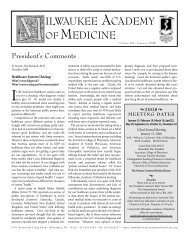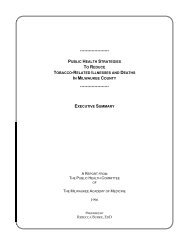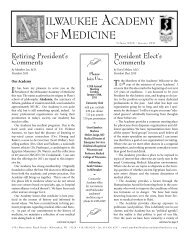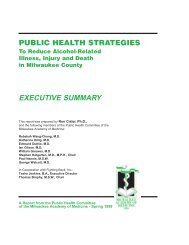2012 January Newsletter - Milwaukee Academy of Medicine
2012 January Newsletter - Milwaukee Academy of Medicine
2012 January Newsletter - Milwaukee Academy of Medicine
You also want an ePaper? Increase the reach of your titles
YUMPU automatically turns print PDFs into web optimized ePapers that Google loves.
From the <strong>Academy</strong>’s Rare Book Collection<br />
Review by H.D. Kerr, M.D.<br />
Thomas Bartholin (1616-1680)<br />
Thomas Bartholin was a<br />
noted Danish physician<br />
<strong>of</strong> the 17th century who<br />
made lasting contributions in<br />
defining the lymphatics as a<br />
body system and in the teaching<br />
<strong>of</strong> medicine. Born in<br />
Copenhagen, he was the son <strong>of</strong><br />
Casper Bartholin, chief <strong>of</strong><br />
medicine at the University <strong>of</strong><br />
Copenhagen and one <strong>of</strong> twelve<br />
eminent family members who<br />
became pr<strong>of</strong>essors there over<br />
three generations. The university<br />
was founded in 1475, one<br />
<strong>of</strong> the earliest in northern<br />
Europe. Although beset by religious<br />
controversies it grew to<br />
become a prestigious institution<br />
largely because <strong>of</strong> the<br />
work and achievements <strong>of</strong> the<br />
remarkable Bartholin family.<br />
Although Copenhagen’s<br />
population at that time was<br />
25,000 the seaport city thrived<br />
because <strong>of</strong> its strategic location.<br />
The North Sea ends at<br />
the barrier <strong>of</strong> the Jutland<br />
peninsula. The waters <strong>of</strong> the<br />
west-flowing Baltic pass<br />
through the many islands east<br />
<strong>of</strong> Jutland and separate<br />
Copenhagen from the Swedish<br />
shore by the narrow Ore<br />
Sound. The Baltic extends<br />
nearly 1000 miles northeast,<br />
connecting with Novgorod<br />
and through the Volga and<br />
Dnieper Rivers to southeast<br />
Europe and on by caravan to<br />
Baghdad. From the Middle<br />
Ages forward sea trade was<br />
heavy in this area, promoted<br />
and guided first by the Vikings<br />
and succeeded by the<br />
Hanseatic League <strong>of</strong> cities.<br />
Trade brought new methods<br />
Th. Bartholini. De Sanquine<br />
Vetito Disquisitio Medica: Cum<br />
Cl. Salmasii Judicio. Frank<strong>of</strong>urti :<br />
P. Hauboldi, 1673.<br />
Thomae Bartholini Opuscula<br />
Nova Anatomica: De Lacteis<br />
Thoracicis Et Lymphaticis Vasis,<br />
Uno Volumine comprehensa/ Ab<br />
Autore Aucta & Recognita.<br />
Franc<strong>of</strong>urti: D. Paulli, 1670.<br />
(Readex Microprint, 1972. New<br />
York...Landmarks <strong>of</strong> Science).<br />
Thomae Bartholini Casp. Filii De<br />
Luce Animalium Libri III.<br />
Admirandis Historiis<br />
Rationibusque Novis Referti.<br />
Lugduni Batavorum: ex <strong>of</strong>ficina<br />
Francisci Hackii, 1647.<br />
Anatome Quartum Renovata:<br />
Non Tantum Ex Institutionibus B.<br />
M. Parentis, Caspari Bartholini,<br />
Sed Etiam Ex Omnium Cum<br />
Veterum, Tum Recentiorum<br />
Observationibus, Ad<br />
Circulationem Harveianam, &<br />
Vasa Lymphatica Directis, Cum<br />
Iconibus Novis Et Indicibus /<br />
Thomoe Bartholini. Lugduni<br />
(Batavorum Leyden) : Sumpt.<br />
Marci & Joan.<br />
Henrici Huguetan, 1684.<br />
Thomae Bartholini Anatome Ex<br />
Omnium Veterum<br />
Recentiorumque Observationibus<br />
Inprimis Institutionibus B.M.<br />
Parentis Caspari Bartholini, Ad<br />
Circulationmem Harvejanem,<br />
Et Vasa Lymphatica<br />
Quartum Renovata.<br />
Lugduni Batavorum (Leyden):<br />
ex Officina Hackiana, 1673.<br />
4 <br />
and materials, knowledge, and<br />
interchange <strong>of</strong> ideas. A renaissance<br />
grew here nearly as<br />
early as in Italy.<br />
Casper Bartholin the<br />
Elder (1585-1629) published<br />
the first edition <strong>of</strong> his celebrated<br />
anatomy textbook with<br />
illustrations in 1611. The text<br />
was later continued and edited<br />
by his son,Thomas and<br />
grandson Casper. At age 19<br />
Casper the Elder travelled<br />
throughout Europe first<br />
studying theology and philosophy,<br />
then medicine (2). At<br />
Padua he was taught anatomy<br />
by Hieronymus Fabricius<br />
(1537-1619) who also taught<br />
William Harvey (1578-1657).<br />
He organized his textbook<br />
from his Padua notes and<br />
sketches. Thomas‘ grandfather,<br />
Thomas Finke (1561-<br />
1656) was a pr<strong>of</strong>essor <strong>of</strong> medicine<br />
also as was Thomas’<br />
uncle, Ole Worm (1588-1654).<br />
At age 16 Thomas’ father died<br />
and Ole Worm became his<br />
guardian, providing him with<br />
well considered advice, steady<br />
guidance, and able assistance<br />
especially regarding his education.<br />
This sustained him.<br />
Thomas later discovered isolated<br />
bones within the sutures<br />
<strong>of</strong> the skull that he named<br />
“wormian bones” after his<br />
esteemed guardian.<br />
Thomas entered the<br />
University <strong>of</strong> Copenhagen in<br />
1634 as a student <strong>of</strong> theology.<br />
In his third year he was<br />
awarded a royal scholarship<br />
that permitted him to study at<br />
Europe’s best universities. He<br />
did so eagerly for the next<br />
Continued on page 5








